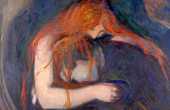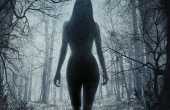Emily Deibler
Received a B.A. in English in 2017. Author of Dove Keeper, Birds in a Cage, and Rabbit Heart. Huge witchy nerd. Horror film lover. I really like bats.
Correspondent I
- Plebian Penman
- Lurker
- Pssst
- Hand Raiser
- Vocal
- Outspoken
- Extrovert
- Center of Attention
- Sharp-Eyed Citizen
- Town Watch
- Detective Deskman
- Penman Patrol
- Actor
- Article of the Month
- ?
- Articles
6 - Featured
6 - Comments
397
- Ext. Comments
234 - Processed
131 - Revisions
70
- Topics
11 - Topics Taken
11 - Notes
83
- Topics Proc.
545 - Topics Rev.
54
- Points
3846 - Rank
13 - Score
3646
Latest Articles
Latest Topics
Published | The Religious Politics of Hellsing UltimateExamine the religious politics of Hellsing Ultimate and how the conflict between the Protestants (The Hellsing Organization) and the Catholics (The Iscariot Organization) impacts the narrative and echoes past and current real life tensions. Possible real life issues to explore are the differences between Protestant and Catholic doctrines and the cultural influence of the Protestant Reformation, especially in England, given that the main setting of Hellsing is London.
|
Race and Gender in Sleepy HollowSleepy Hollow is a supernatural show with a black female lead (Abbie) and a white male lead (Ichabod). At times, especially in the second season, Abbie would be sidelined so the narrative could focus more on Ichabod’s love life, and now, as of the season three finale, Abbie has been killed for Ichabod’s sake. Analyze the intersected representation of both race and gender in Sleepy Hollow. How is Abbie portrayed compared to her white male counterpart? How are other characters, such as Frank and Jenny, treated within the show’s narrative? When it comes to attempts to portray female characters other than Abbie, how are they presented? What is the effect of the characters of color who only appear when their culture is appropriated for story purposes? (Big Ash.)
|
Sims 4's Increased Gender DiversityRecently, Sims 4 received an update that allows players more options to customize their Sims’ gender identities and personal expression. The update includes new choices where the player can decide 1) whether their character’s frame is masculine or feminine, 2) whether the character prefers clothes deemed masculine or feminine, 3) whether the character can become pregnant, and 4) whether the character can use the toilet standing up. What impact will being more inclusive to gender identities beyond strict binary norms have for players, especially for players who are not cisgender? Are there any games that provide similar options or ways of pushing gender boundaries? Would it be beneficial for more games to adopt similar means of customization? Are there ways the Sims could go even further to explore gender identity? |
Mercy and Revenge in DishonoredDishonored is a stealth game where the main character is an assassin/bodyguard named Corvo Attano. After Corvo is framed for killing the queen, he embarks on a mission to find and rescue her daughter. During this quest, the player can choose to kill several targets (High Chaos) or find other means to incapacitate and evade enemies (Low Chaos). These choices affect the difficulty level and ending of the game; High Chaos causes more guards, rat swarms, and plague victims (zombies) to appear in areas. As well as that, non-hostile NPCs tend to become more openly hostile or nihilistic. However, many of the merciful quest options include ruthless endings for Corvo’s targets, even when he is ultimately sparing their lives. The targets are often subjected to more suffering, though the result is a less imbalanced world. Analyze how Dishonored explores the concepts of mercy and revenge with its Chaos system. What do the environmental consequences and brutal depictions of mercy say about Dishonored’s world and the notion of vengeance?
|
Death in Medieval English LiteratureExplore how Medieval English literature deals with the theme of death. For real life context, the article could examine the devastating impact of the bubonic plague on not just England, but the whole of Europe. The quick spread and constant recurrences of the Black Death (as well as the high casualties) spurred contemplations about death, mortality, and religion. Examples of works that capture the anxiety of impending death are “Gawain and the Green Knight” (and most tales involving King Arthur’s court), “The York Play of the Crucifixion,” and the morality play “Everyman.” What do these stories say about how one should spend their time before death? Why is there an emphasis on urgency? In stories where death is personified, what is its true nature?
|
Social Issues in Flannery O’Connor’s Short StoriesExamine the social issues Flannery O’Connor explores in her short stories, as well as any potential historical contexts. O’Connor’s short stories primarily take place in the Deep South (O’Connor was Georgian) and create a Southern Gothic atmosphere. They also depict life during the Jim Crow era. Issues to explore could be religion (O’Connor was a staunch Catholic in the heavily Protestant South), Old versus New (post-Civil War, post-Reconstruction) South, race, and class. Examples: “A Good Man is Hard to Find”: This short story deals with the conflict between the Old South and the newer generation. The grandmother of the family reminisces on how the Old South was better than modern times and how children now have no appreciation or respect for their own state. Also, when the grandmother encounters a serial killer, she tries to argue about morality and religion to spare her own life. “The Artificial N*****”: This story, with a racial epithet in its title, deals with a poor white man (Mr. Head) and his grandson going to Atlanta, which contains more black people than the rural area. Class and race intersect as Mr. Head grooms his grandson to have a prejudice against black people, and the grandfather expresses resentment and insecurity at seeing a wealthy black man, as well as when he believes he will not be able to “teach” his grandson racism. The title refers to Jim Crow-era statues that depicted extremely grotesque and demeaning caricatures of black people, which also connects to minstrel shows (performances that depict white people in blackface). Other potential short stories and issues to explore are 1) xenophobia and the Holocaust in “The Displaced Person” and 2) disability in “The Life You Save May Be Your Own.” (O’Connor suffered from lupus, an autoimmune disease that made her body deteriorate until her death.) |
Impact of Setting in The Lives of the Mayfair WitchesAnne Rice’s The Lives of the Mayfair Witches (1990-1994) is a Gothic horror trilogy that involves the history of a family of witches. Starting with The Witching Hour, the prose goes to great lengths to describe both antebellum and contemporary New Orleans. There are florid descriptions of the heat, the cracked streets, the rotting architecture, and the sprawling flora overtaking the Mayfair manor. Points of analysis: What impact does the vivid imagery have on establishing the atmosphere and the history of the location? How does this incredibly detailed, setting-focused technique connect to other works of Southern Gothic literature, such as Harper Lee’s To Kill a Mockingbird or Flannery O’Connor’s short stories? How do the elaborate descriptions affect the more fantastical or surreal aspects of Gothic horror?
|
White Leads and Race in Horror FilmsMovies such as The Grudge, The Forest, and The Other Side of the Door take place in countries such as Japan and India. However, rather than the protagonists being people of color, the lead roles tend to go to white American or English actresses such as Sarah Michelle Gellar, Natalie Dormer, and Sarah Wayne Callies. Indeed, white people do exist in these countries, but there is a dearth of leads of color in horror, even when a white person would likely be the setting’s racial minority. Analyze the potential racial implications. What are the possible reasons for casting predominantly white actors (for example, the often-cited “star power”), and does this suggest anything about the horror genre and its treatment of race? Are there any films that do not adhere to this trend? Going beyond white characters abroad as the premise, the article could possibly unpack horror movies such as Night of the Living Dead (black male protagonist killed by mistaken gunfire) and Candyman (black male antagonist killed by mob for an interracial relationship with a white woman).
|
Latest Comments
| Charlotte Turner Smith: Empowering Women with a Sonnet | |
Ah, I thought so! It’s a great article. 🙂 | The Religious Politics of Hellsing Ultimate |
Hey, I think I suggested a topic of a similar nature, and I’m so happy to see someone wrote on it! I like how you tie in the Irish/English connection when it comes to the religious frictions, as the English Protestants versus the Irish Protestant (Anderson) is a very stark conflict with ties to British imperialism and the fraught Christian schism. | The Religious Politics of Hellsing Ultimate |
Good point! Midsommar does tap into that film plot subgenre of people going to a location unfamiliar to them and being threatened. This appears in a variety of ways in horror movies. | Midsommar: The Horrors of a Toxic Relationship |
Hi proflong, thank you for your detailed response! I agree that I love that most of the horror occurs in the day, and that, plus the beautiful costumes, is actually more offputting than darkness because the beauty and serenity are shot the same as the violence. I also enjoy how Aster’s horror films are intense character studies and family dramas. I’d say they’re both–though horror often gets a bad rap, films in this genre have often been metaphorical and complex, such as The Exorcist showing a young woman being possessed after her parents divorce; the physical ailments and behavioral changes mirror how one might feel during an extreme emotional low or struggles with one’s mental health during a big change. Her mother feels frustrated and utterly helpless when she watches her daughter undergoing tests. This struggle with change and transformation also comes at a time when the main priest character has lost his mother and feels extreme guilt because his religious profession meant his mother died in poor conditions rather than a better but costlier facility. Admittedly, I struggled with Hereditary because, at the end of the day, I had similar feelings as I did when seeing The Killing of a Sacred Deer. They’re very similar movies with their Greek myth references and the idea that a fatal flaw and ability to overcome dooms the characters to a terrible fate. While I respect these narrative choices, the fatalist and hopeless ending just isn’t really something I enjoy. I don’t need a purely happy ending, but I don’t like something that’s bleak at the finish, though arguably it could be seen as a ballsy move. I like dark, but I prefer stories that have some hope, no matter how scant. It’s not a flaw with the movies, just a personal preference. But what I like about Midsommar is how complicated the ending is. It could be seen as an esoteric happy ending, but the fact Dani has essentially been manipulated into her situation, and so was Christian, darkens the idea that she has finally found a new family of people who care for her. What will what she’s been through and what she’s seen affect her going forward? Can she truly be happy? Christian wasn’t a good person, but his punishment was devastatingly severe, especially when his infidelity–what he’s killed for–was coerced. It’s these layers that really make me appreciate the story and the film as a whole. | Midsommar: The Horrors of a Toxic Relationship |
Interesting points. I think the fear in Midsommar has a lot to do with grief and isolation, but horror is often a tough genre to pin down because fear is so individualistic. | Midsommar: The Horrors of a Toxic Relationship |
Thank you! | Midsommar: The Horrors of a Toxic Relationship |
He was drugged and manipulated into the situation. That’s rape. And after we saw what happened to anyone who displeased the Hårga for whatever reason, I highly doubt things would’ve gone well if he tried to walk away. | Midsommar: The Horrors of a Toxic Relationship |






Wow! I remember in my English undergrad I wrote about Smith for British lit. It was amazing learning and reading about a female poet in a genre (Romantic poetry) where mostly men receive recognition.
I enjoyed your analysis of her poems, especially the sea metaphor. It was very insightful.